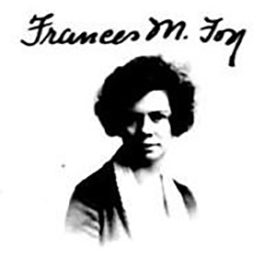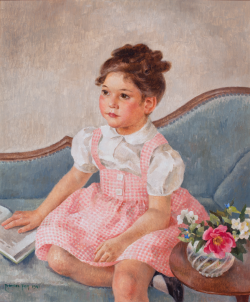Frances Foy, from a passport photograph (www.ancestry.com).

Frances Foy 1890–1963
Associated with Chicago’s community of progressive artists early in her career, Frances Foy was a commercially successful illustrator, painter, and printmaker whose works include portraits, still lifes, and scenes of everyday life. Foy was born in Chicago and raised in suburban Oak Park. At school she demonstrated a talent for drawing, and she spent a summer at the Chicago Academy of Fine Arts (founded in 1902), studying with portraitist Wellington Reynolds. Foy began working as a fashion illustrator before enrolling in evening classes at the Art Institute of Chicago’s school, where she again worked under Reynolds. She was influenced by visiting instructors George Bellows and Randall Davey, who inspired a generation of young “rebels” among Chicago’s artists. They included painter Gustaf Dalstrom, whom Foy married in 1923.
Foy began exhibiting her paintings as early as 1922, when her works first appeared in the exhibitions of the No-Jury Society of Artists exhibitions, an alternative to the Art Institute’s annual shows. By 1926 the Art Institute was displaying her canvases as well. Foy and Dalstrom exhibited with the so-called Fifty-Seventh Street art colony, and both were elected directors of the No-Jury Society. Foy’s work was featured in solo exhibitions sponsored by the Chicago Woman’s Aid club in 1927 and at the Romany Club the next year. Also in 1928, she and her husband traveled throughout Europe. Foy received a gold medal from the Chicago Society of Artists in 1929, the year she was given a small solo exhibition at the Art Institute. She received several awards at the museum’s annual exhibitions during the early 1930s. In that decade she also exhibited with The Ten (or 10 Artists), a group of modernist painters that included Dalstrom and Jean Crawford Adams as well. Foy was among the artists featured in J. Z. Jacobson’s 1932 book Art of Today: Chicago, 1933, a compendium of Chicago modernist practitioners.
In the 1930s Foy painted several post office murals under the auspices of federal government New Deal relief programs, and she served on the technical committee of the Treasury Department’s Public Works of Art Project. Floral still-life images dominated Foy’s mature work as a painter in oils and watercolors. Alongside her husband in the studios of Hull-House, Foy also learned to make etchings. In the 1930s the couple collaboratively illustrated an anatomy book. Their paintings of the Lincoln Park neighborhood, where they lived for many years, were featured in a joint exhibition at the Chicago Historical Society in 1948. Foy’s papers are preserved along with Dalstrom’s in the collection of the Archives of American Art, Smithsonian Institution.
Wendy Greenhouse, PhD

